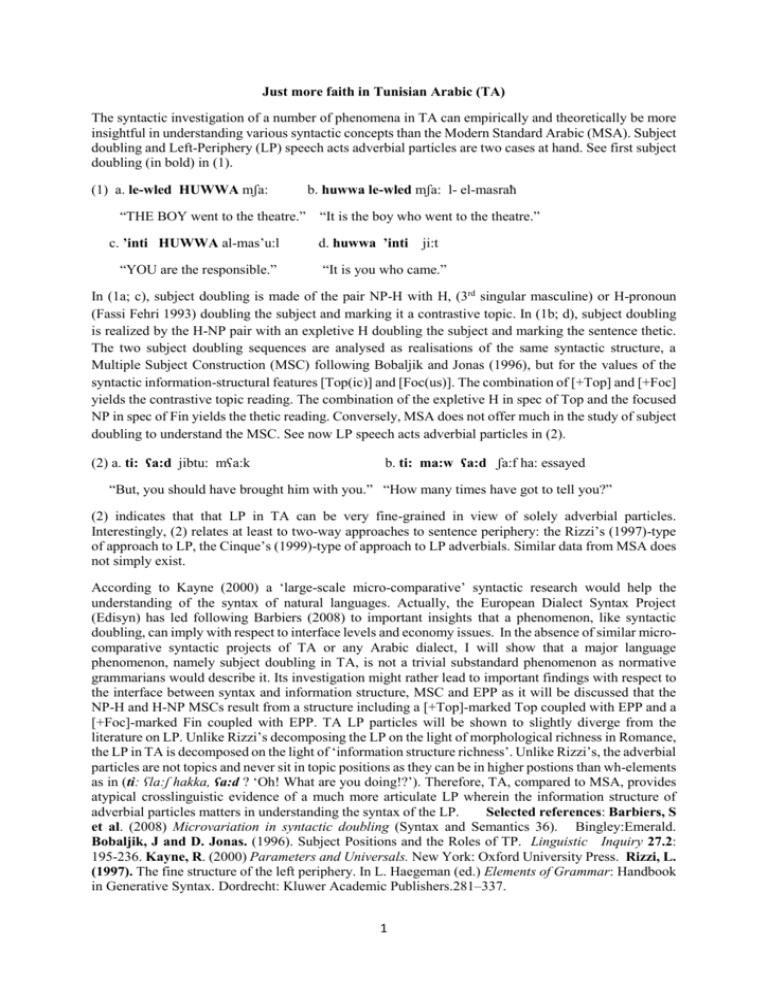abstract
advertisement

Just more faith in Tunisian Arabic (TA) The syntactic investigation of a number of phenomena in TA can empirically and theoretically be more insightful in understanding various syntactic concepts than the Modern Standard Arabic (MSA). Subject doubling and Left-Periphery (LP) speech acts adverbial particles are two cases at hand. See first subject doubling (in bold) in (1). (1) a. le-wled HUWWA mʃa: b. huwwa le-wled mʃa: l- el-masraħ “THE BOY went to the theatre.” “It is the boy who went to the theatre.” c. ’inti HUWWA al-mas’u:l “YOU are the responsible.” d. huwwa ’inti ji:t “It is you who came.” In (1a; c), subject doubling is made of the pair NP-H with H, (3rd singular masculine) or H-pronoun (Fassi Fehri 1993) doubling the subject and marking it a contrastive topic. In (1b; d), subject doubling is realized by the H-NP pair with an expletive H doubling the subject and marking the sentence thetic. The two subject doubling sequences are analysed as realisations of the same syntactic structure, a Multiple Subject Construction (MSC) following Bobaljik and Jonas (1996), but for the values of the syntactic information-structural features [Top(ic)] and [Foc(us)]. The combination of [+Top] and [+Foc] yields the contrastive topic reading. The combination of the expletive H in spec of Top and the focused NP in spec of Fin yields the thetic reading. Conversely, MSA does not offer much in the study of subject doubling to understand the MSC. See now LP speech acts adverbial particles in (2). (2) a. ti: ʕa:d jibtu: mʕa:k b. ti: ma:w ʕa:d ʃa:f ha: essayed “But, you should have brought him with you.” “How many times have got to tell you?” (2) indicates that that LP in TA can be very fine-grained in view of solely adverbial particles. Interestingly, (2) relates at least to two-way approaches to sentence periphery: the Rizzi’s (1997)-type of approach to LP, the Cinque’s (1999)-type of approach to LP adverbials. Similar data from MSA does not simply exist. According to Kayne (2000) a ‘large-scale micro-comparative’ syntactic research would help the understanding of the syntax of natural languages. Actually, the European Dialect Syntax Project (Edisyn) has led following Barbiers (2008) to important insights that a phenomenon, like syntactic doubling, can imply with respect to interface levels and economy issues. In the absence of similar microcomparative syntactic projects of TA or any Arabic dialect, I will show that a major language phenomenon, namely subject doubling in TA, is not a trivial substandard phenomenon as normative grammarians would describe it. Its investigation might rather lead to important findings with respect to the interface between syntax and information structure, MSC and EPP as it will be discussed that the NP-H and H-NP MSCs result from a structure including a [+Top]-marked Top coupled with EPP and a [+Foc]-marked Fin coupled with EPP. TA LP particles will be shown to slightly diverge from the literature on LP. Unlike Rizzi’s decomposing the LP on the light of morphological richness in Romance, the LP in TA is decomposed on the light of ‘information structure richness’. Unlike Rizzi’s, the adverbial particles are not topics and never sit in topic positions as they can be in higher postions than wh-elements as in (ti: ʕla:ʃ hakka, ʕa:d ? ‘Oh! What are you doing!?’). Therefore, TA, compared to MSA, provides atypical crosslinguistic evidence of a much more articulate LP wherein the information structure of adverbial particles matters in understanding the syntax of the LP. Selected references: Barbiers, S et al. (2008) Microvariation in syntactic doubling (Syntax and Semantics 36). Bingley:Emerald. Bobaljik, J and D. Jonas. (1996). Subject Positions and the Roles of TP. Linguistic Inquiry 27.2: 195-236. Kayne, R. (2000) Parameters and Universals. New York: Oxford University Press. Rizzi, L. (1997). The fine structure of the left periphery. In L. Haegeman (ed.) Elements of Grammar: Handbook in Generative Syntax. Dordrecht: Kluwer Academic Publishers.281–337. 1







